There are several ways to measure the rate of use of propane.
Direct Measurement with Gas Meter
This is the most accurate but also the least practical method. EK Metering sells a small gas meter EKM-APGM-075-CF for about $150 which can be inserted in the low pressure gas lines feeding each appliance. The meter provides direct readout in cubic feet with a resolution of 0.1 cu ft. It also provides a pulse output every 1 cu ft which can be connected to the EKM Omnimeter and Push Control System discussed on the Water Measurements page. This feature is very handy for correlating hot water usage with gas consumption, for example. The photo below shows the meter connected to the upstairs hot water heater gas line.
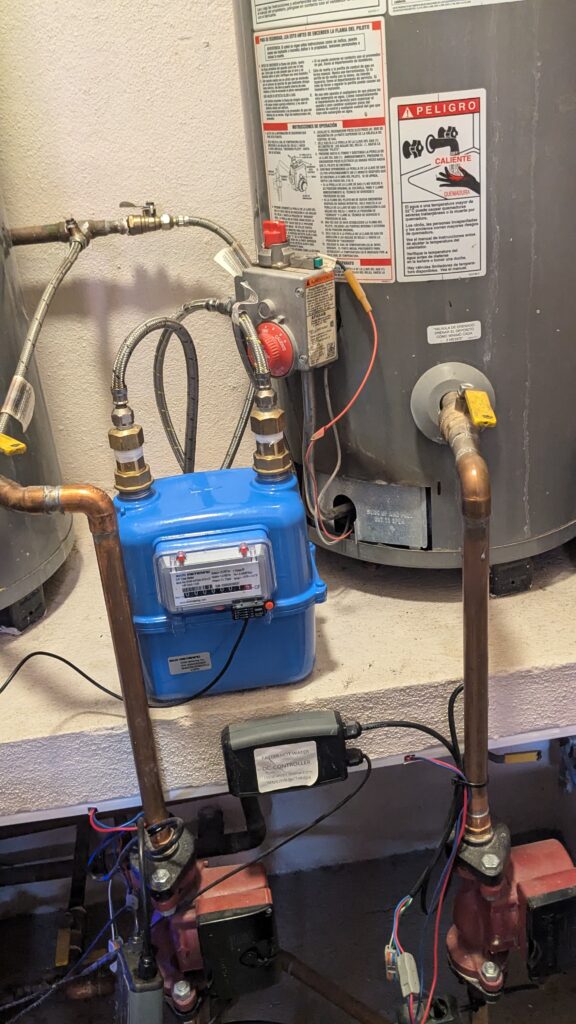
The meter comes with the fittings shown except for the brass 3/8 inch flare to 3/4 inch NPT adapters. These are hard to find locally but are available on eBay.
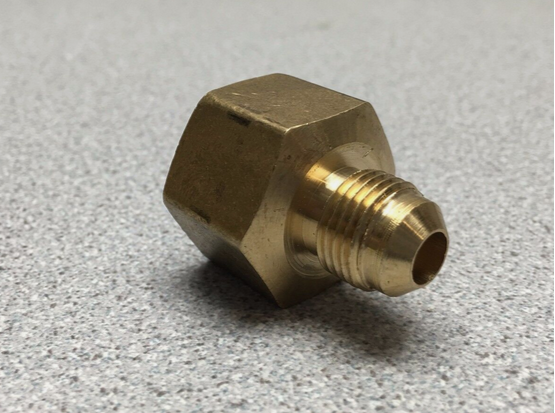
The main consumers of gas are the hot water heaters and the stove/oven. The usage of gas in the hot water heaters is relatively easy to measure since the gas connections are located near the Omnimeter and Push and are flexible flare fitting connected hoses. A typical measurement taken from the on line EKM data site for the upstairs water heater is shown below. The graph shows the pulse count increasing 6 pulses during a shower.
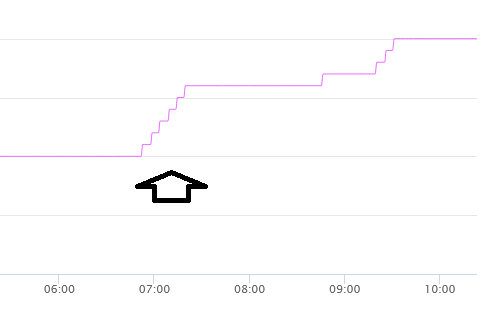
Six pulses corresponds to 6 cu ft of propane. Each pulse or cubic foot of propane at 60 deg F and 15.1 psia has a mass of 1.23 mols or 54.3 grams or 0.120 lbs. For details of these calculations see the page Propane Calculations. In liquid form this has a volume of 0.111 liters. It has an energy content of 2664 BTUs. These conversion factors make it easy to calculate the consumption of gas from the pulse count.
So the hot water associated with this shower required 0.666 liters of propane and consumed 15,984 BTUs of energy. This was a 6 minute shower that used 10.5 gallons of water. That is over half the total capacity of the hot water heater shown (76 liters or 20 gal).
It is also useful to measure the average consumption of propane by this hot water heater over a longer time period to estimate the usage in liters per day.
Estimating Usage from BTU Ratings
Every gas appliance has an energy consumption rating which can be found on the name plate or online from the model number. It is usually given in British Thermal Units (BTUs), but this is actually the power rating in BTUs/hr and must be multiplied by time to get the energy consumption in BTUs. Alternatively it may also be given in kilowatts (kW). This is also power and can be converted to BTU/hr by multiplying it by 3412.
Propane has an energy content of about 24,000 BTUs per liter so we simply divide the number of BTUs used per day by 24,000 to get the daily propane usage in liters per day. For example, our hot water heater is rated at 5.8 kW, and I estimate its burner is on 1 hour per day.
Energy Used per day = (3412 BTU/hr per kW) x 5.8 kW x 1 hr per day usage = 19,790 BTUs per day
Propane Used per day = 19,790 BTU / 24,000 BTU per liter = 0.82 liters per day
The table below lists all the gas appliances in our house, their BTU ratings and estimated usage per day. The table separates summer and winter as the heaters and fireplace logs are only used for 3 months of the year.
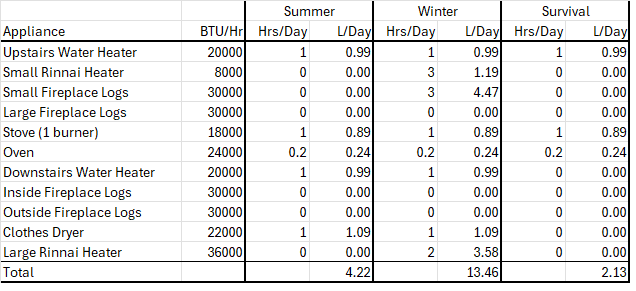
For survival, only the upstairs water heater and range/oven would be used.
Estimating Usage from Tank Level
The tank should filled when it reaches anywhere from 50% to 20%, and it should be filled to about 85% to 90% to allow for expansion. There is a remote digital readout of the analog gauge mounted on the tank which uses a float system to measure the percentage fill level. So for a 1000 liter tank, 75% corresponds to 750 liters remaining. The advantage of this system is that it is very convenient to use, and it’s especially convenient for knowing when the tank needs refilling. However, the system is not very accurate as it assumes the tank is rectangular in shape rather than cylindrical, and the resolution of the digital readout is 1%. But on a 1000 liter tank, 1% is 10 liters which is about the same magnitude as the daily usage. So it is necessary to wait for a change of about 100 liters (10 days) to get a reasonable estimate of the daily consumption. In addition, there is a significant difference between the propane added based on the difference in gauge levels before and after filling and the propane added based on the metered (billed) amount delivered by the truck. The table below shows this discrepancy for the last two fillings.

The billed amounts are about 81.5% of the amounts indicated on the digital gauge. Since it is inconceivable that the propane company is under billing us by nearly 20%, the conclusion is that the billed quantity is the correct one.
Incidentally, the difference between the liquid volume of a cylindrical and rectangular tank indicated by the float level is not as great as might be expected. The following graph compares the two for an assumed tank size of 38.1 cm radius by 219 cm length. The difference is less than 10%.
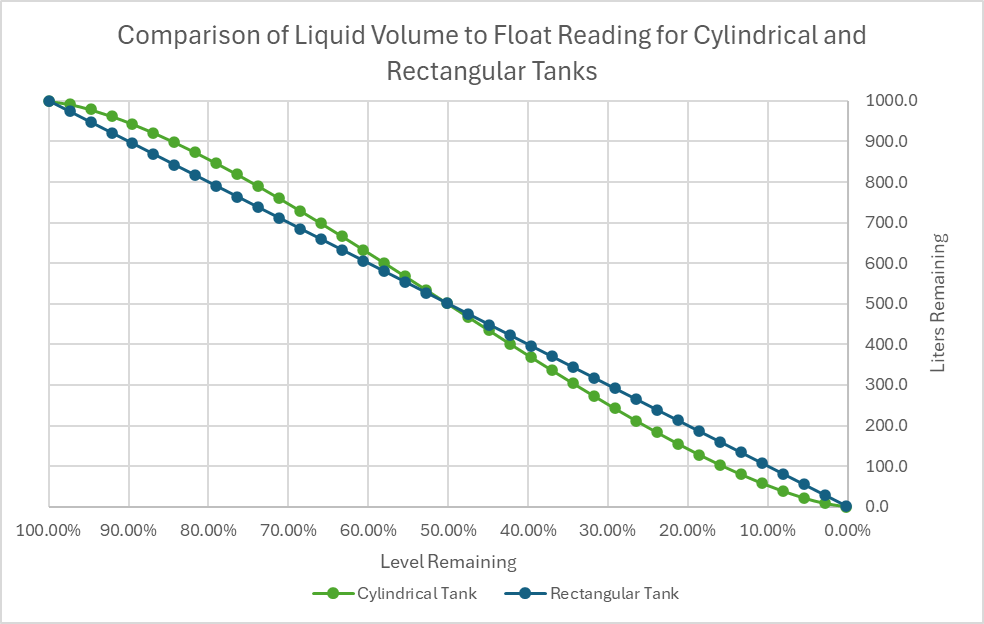
Comparison of Methods
The chart below compares the propane usage based on the billed amount delivered, the uncorrected digital gauge readings and a simple estimate based on the BTU usage for summer and winter months.
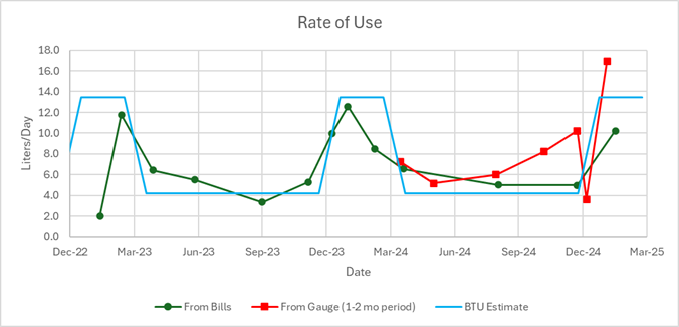
In the above graph, the dark green dots show the rate of use derived from the billing data. For comparison, the red squares correspond to the tank level remote reading but over intervals corresponding to 1 or 2 months each. The blue curve is the estimate based on the BTU calculations with winter usage assumed for the months of December through February and summer usage for the other months.
For predicting the survival usage, the BTU calculation is the easiest and best method.